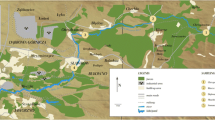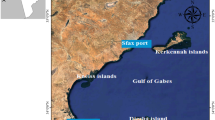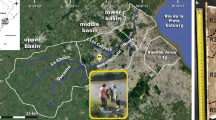Abstract
The Bothnian Bay, which is the northernmost part of the Gulf of Bothnia in Northern Finland, is affected by effluents discharged from point sources such as the pulp and paper mills of Stora Enso Oyj Veitsiluoto Mill and Oy Metsä-Botnia Ab Kemi Mill at Kemi, and the Kemi municipal sewage plant, as well as the River Kemijoki. In this paper we discuss, how modernisation of the wastewater treatment plant at the mills, and process investments in the Best Available Techniques (BAT) for effluent treatment, have decreased the effluent discharges of biological oxygen demand (BOD), chemical oxygen demand (COD), total phosphorus (Tot-P), total nitrogen (TOT-N), total suspended solids (TSS) and adsorbable organically bound halogens (AOX) from the mills since 1988. One specific aim of the study was to determine the EOX (Extractable Organically Bound Halogens) concentrations in bottom sediment of the Bothnian Bay in order to assess whether the EOX concentrations reflect the reduction in discharges of chlorinated compounds. According to the monitoring program carried out every third year between 1997–2006, the decreasing trend in EOX concentrations in the top 2 cm of the bottom sediment reflect the decrease in organochlorine discharges (AOX) from the mills. In 1997 the EOX concentrations in bottom sediment varied between 3–70 μg of Cl g−1 (dry weight), and in 2006 between 3.3–32 μg of Cl g−1 (dry weight).
Similar content being viewed by others
References
Ekono. (2002). Environmental performance, regulations and technologies in the pulp and paper industry, 728 pp. Ekono/Duoplan Strategy Study.
Finnish Standard Association. (1997). SFS-EN Standard 1485. Water quality. Determination of adsorbable organically bound halogens (AOX), 20 pp. Helsinki, Finland: Finnish Standard Association.
Finnish Standard Association. (1998a). SFS-EN Standard 1899-1. Water quality. Determination of biological oxygen demand after n days (BODn). Part 1: Dilution and seeding method with allylthiourea addition (ISO 5815: 1989, modified, 24 pp. Helsinki, Finland: Finnish Standard Association.
Finnish Standard Association. (1988b). SFS-EN Standard 5505. Determination of inorganic and organic nitrogen in waste water. Modified Kjeldahl method, 4 pp. Helsinki, Finland: Finnish Standard Association.
Finnish Standard Association. (1988c). SFS Standard 5504. Determination of chemical oxygen demand (CODcr) in water with the closed tube method. Oxidation with dichromate, 4 pp. Helsinki, Finland: Finnish Standard Association.
Finnish Standard Association. (1998d). SFS-EN ISO Standard 11905-1. Water quality. Determination of nitrogen. Part 1: Method using oxidative digestion with peroxodisulfate (ISO 11905.1:1997), 23 pp. Helsinki, Finland: Finnish Standard Association.
Finnish Standard Association. (2000). ISO Standard 9001. Quality management systems–requirements, 23 pp. Helsinki, Finland: Finnish Standard Association.
Finnish Standard Association. (2004a). SFS-EN ISO Standard 6878. Water quality. Determination of phosphorus. Ammonium molybdate spectrometric method, 21 pp. Helsinki, Finland: Finnish Standard Association.
Finnish Standard Association. (2004b). ISO Standard 9562. Water quality. Determination of adsorbable organically bound halogens (AOX), 21 pp. Helsinki, Finland: Finnish Standard Association.
Finnish Standard Association. (2005). SFS-EN Standard 872. Water quality. Determination of suspended solids. Method by suspended solids. Method by filtration through glass fibre filters, 11 pp. Helsinki, Finland: Finnish Standard Association.
Harila, P., & Kivilinna, V. A. (1999). Biosludge incineration in a recovery boiler. Water Science and Technology, 40, 195–200.
Hasegawa, M., & Barton, D. (1997). The effects of oxygen delignification, complete chlorine dioxide substitution, and biological treatment on bleached kraft mill effluent quality. Water Science and Technology, 35, 1–6.
Hayer, F., Wagner, P., & Pihan, J. C. (1996). Monitoring of extractable organic halogens (EOX) in chlorine bleached pulp and paper mill effluents using four species of transplanted aquatic mollusks. Chemosphere, 33, 2321–2334.
Jonsson, P., Grimvall, A., Cederlöf, M., & Hilden, M. (1996). Pollution threats to the Gulf of Bothnia. Ambio, 8, 22–27.
Kähkönen, K. (1999). Ecotoxicology and biogeochemical functioning of bleached pulp mill recipient and non-recipient lake sediments. Dissertation, University of Helsinki. Available from: <http://urn.fi/URN:ISBN:951-45-8705-7>, accessed on May 2007.
Kähkönen, M., Suominen, K., Manninen, P., & Salkinoja-Salonen, M. (1998). 100 Years of sediment accumulation history of organic halogens and heavy metals in recipient and nonrecipient lakes of pulping industry in Finland. Environmental Science and Technology, 32, 1741–1746.
Kankaanpää, H., Lauren, M., Saares, R., Heitto, L., & Suursaar, U. (1997). Distribution of halogenated organic material in sediments from anthropogenic and natural sources in the Gulf of Finland Catchment area. Environmental Science and Technology, 31, 96–104.
Kankaanpää, H., & Tissari, J. (1994). Analysis of EOX and AOX in two industry influenced coastal areas in the Gulf of Finland–levels of EOX and AOX in the Kotka region, Finland levels of EOX in the Neva Bay, Russia. Chemosphere, 29, 241–255.
Kannan, K., Kawano, M., Kashima, Y., Matsui, M., & Giesy, J. (1999). Extactable organohalogens (EOX) in sediment and biota collected at an estuarine marsh near a former chloralkali facility. Environmental Science and Technology, 33, 1004–1008.
Kauppila, P., & Bäck, S. (2001). The state of Finnish coastal waters in the 1990s. Finnish Environment Institute. Report 472. 131 pp.
Kostamo, A., Holmbom, B., & Kukkonen, J. (2004). Fate of wood extractives in wastewater treatment plants at kraft pulp mills and mechanical pulp mills. Water Research, 38, 972–982.
Kukkonen, J., Eadie, B., Oikari, A., Holmbom, B., & Lansing, M. (1996). Chlorophenolic and isotopic tracers of pulp mill effluent in sedimenting particles collected from southern lake Saimaa, Finland. Science of the Total Environment, 188, 15–27.
López, M. (2003). Determination of potentially bioaccumulation complex mixture of organochlorine compounds in wastewater: A review. Environment International, 28, 751–759.
Martinsen, K., Kvernheim, A., & Carlberg, G. (1994). Distribution of organohalogen in sediments outside pulp mill using sum parameters. Science of the Total Environment, 144, 47–57.
Niemirycz, E., Kaczmarczyk, A., & Blažejowski, J. (2005). Extractable organic halogens (EOX) in sediments from selected Polish rivers and lakes–a measure of the quality of the inland water environment. Chemosphere, 61, 92–97.
Nilsson, P., Jansson, M., & Brydsten, L. (2003). Retention and long term accumulation of EOCL from pulp mill effluents in a Baltic Sea recipient. Water, Air, and Soil Pollution, 143, 225–243.
Ogden, G. (1972). Oxygen demand of effluent from a bleached kraft pulp mill. Water, Air, and Soil Pollution, 1, 365–374.
Palm, H., & Lammi, R. (1995). Fate of pulp mill organochlorines in the Gulf of Bothnia sediments. Environmental Science and Technology, 29, 1722–1727.
Pokhrel, D., & Viraraghavan, T. (2004). Treatment of pulp and paper mill wastewater–a review. Science of the Total Environment, 333, 37–58.
Pöykiö, R., Taskila, E., Perämäki, P., Nurmesniemi, H., Kivilinna, V. A., Kuokkanen, T., et al. (2004). Sediment, perch (Perca fluviatilis) and bottom fauna as indicators of effluents discharged from the pulp and paper mill complex at Kemi, Northern Finland. Water, Air and Soil Pollution, 158, 325–343.
Pöykiö, R., & Torvela, H. (2001). Pine needles (Pinus sylvestris) as a bioindicator of sulphur and heavy metal deposition in the area around a pulp and paper mill complex at Kemi, Northern Finland. International Journal of Environmental Analytical Chemistry, 79, 143–154.
Saares, R., Vaskonen, K., & Ahtiainen, J. (1995). Sedimentin orgaanisten klooriyhdisteiden EOX -määritysmenetelmä ja sen validointi. Moniste nro: 621. Vesi-ja ympäristöhallitus. Helsinki. Finland. (in Finnish). 38 pp.
Sibley, P., Dixon, D., & Barton, D. (1998). Environmental assessment of benthic impacts associated with pulp mill discharges. II. Distribution of sediment EOX in relation to environmental factors. Archives of Environmental Contamination and Toxicology, 34, 158–166.
Silvo, K., Jouttijärvi, T., Melanen, M., & Ruonala, S. (2005). Best available techniques (BAT) in the Finnish pulp and paper industry–a critical review. European Environment, 15, 175–191.
Silvo, K., Melanen, M., Honkasalo, A., & Ruonala, S. (2002). Integrated pollution prevention and control–the Finnish approach. Resources, Conservation and Recycling, 35, 87–60.
Solomon, K. (1996). Chlorine in the bleaching of pulp and paper. Pure and Applied Chemistry, 68, 1721–1730.
Suominen, K. (1999). Ecotoxicology and biogeochemical functioning of bleached pulp mill recipient and non-recipient lake sediments. Dissertation, University of Helsinki. Finland. Available from: <http://urn.fi/URN:ISBN:951-45-8705-7>, accessed on May 2007.
Svanberg, O., & Bengtsson, B. (1996). Impact of bleached pulp mill effluents on the aquatic environment (The Swedish Environment/Cellulose Project): A case study. Resources, Conservation and Recycling, 16, 189–199.
Tana, J., & Lehtinen, K. J. (1996). The aquatic environment impact of pulping and bleaching operations–an overview. Finnish Environment Institute. Helsinki. Finland. Report No: 17. 99 pp.
Tantemsapya, N., Wirojanagud, W., & Sakolchai, S. (2004). Removal of colour, COD and lignin of pulp and paper wastewater using wood ash. Songklanakarin Journal of Science and Technology, 26, 1–12.
Tezel, U., Guven, E., Erguder, T., & Demirer, G. (2001). Sequential (anaerobic/aerobic) biological treatment of Dalaman SEKA pulp and paper industry effluent. Waste Management, 21, 717–724.
Author information
Authors and Affiliations
Corresponding author
Rights and permissions
About this article
Cite this article
Pöykiö, R., Nurmesniemi, H. & Kivilinna, VA. EOX concentrations in sediment in the part of the Bothnian Bay affected by effluents from the pulp and paper mills at Kemi, Northern Finland. Environ Monit Assess 139, 183–194 (2008). https://doi.org/10.1007/s10661-007-9825-9
Received:
Accepted:
Published:
Issue Date:
DOI: https://doi.org/10.1007/s10661-007-9825-9




